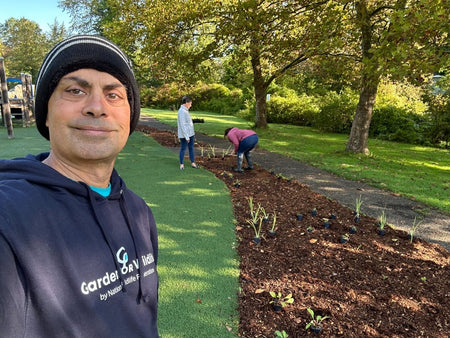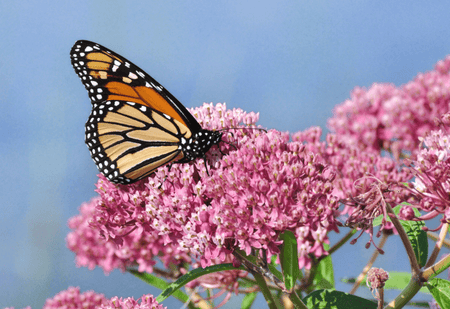Q&A with Garden for Wildlife CEO Shubber Ali

In November, Garden for Wildlife welcomed a new CEO, Shubber Ali. We've seen Shubber profiled before, but we wanted to "dig" in a little more.
QUESTION #1: What drew you most to you want to work with Garden for Wildlife?
Well, considering I was involved in the creation of this business (it's the result of pro-bono work I did with NWF back in 2020 when I was at Accenture) there's really no way I was going to say no when the Board asked me if i would be the CEO of the spinout business :-) It is the ultimate intersection of all my professional experiences to date (innovation, building startups, working with big companies and government, etc) AND my decades of gardening and love of nature.
QUESTION #2: We know you’re a gardener. What was the pivotal moment you shifted to planting native for wildlife?
When I read Doug Tallamy's book, Nature's Best Hope. I've been gardening for decades - going to the local big box garden center and buying flowers and shrubs to put in my yard wherever I lived, thinking I was helping the pollinators and songbirds. So imagine my surprise when I read his book and realized how big the actual problem is for those creatures and that invasive plants are a big part of why they've been in such decline! That's what got me started looking for native plants... only to discover how hard it was to easily find them (those big box stores didn't carry them, which I discovered after hours of taking one plant at a time and looking up the native range to find they were from South America or Asia or the Mediterranean, etc).
QUESTION #3: As a busy CEO, how would you convince someone who thinks they don’t have time to garden for wildlife?
If you garden, it doesn't take any more time than what you're already doing - it's just picking different species, ones that actually evolved to live in the area you are in. So they actually take LESS work in the long run - first, they are suited to the light/soil/water of your area, and second because they are perennials they come back bigger and better in subsequent years, so you save money and time in the long run because you just get to sit back and watch them come up out of the ground in future years (instead of having to go to the store again each year and buy new annuals and then actually do that time consuming prepping/planting work.)
QUESTION #4: Tell us your favorite gardening success story.
It's a work in progress - my current yard. So after I read Tallamy's book, I decided to take a section of my lawn and convert it to a native habitat, with a pond in the middle. So I grabbed a shovel and put in my headphones, and after hours of conference calls for work where I was on mute just listening in while i shoveled (it was the early months of the pandemic), I had an 11'x13' pond.

I dug a LOT.

Then I put a liner in (thanks to thepondguy.com for making that possible!) and filled it up. This is also where I discovered that, living on a well, you can drain a well of water if you take out too much all at once... but it was fine after a few hours of no water in the house.

Then I put native plants around it and mulched (it's supposed to look like a heart when seen from above, in case you're wondering about the strange shape...)
And this is last summer....

The pond also started to attract all sorts of friends who heard about it, including frogs (which i only discovered when one summer night i heard this INCREDIBLE chorus of singing/croaking frogs out in the yard....) and some turtles, including this guy:

QUESTION #5: What wildlife do you see most?
Songbirds - LOTS of songbirds. We are seeing more new and different bird species each year since we started our transformation. When we moved here 4 years ago, I saw my first ever eastern bluebird. But there was just one. This year we have EIGHT nesting pairs in our yard (my daughter and I built birdhouses for them and they all showed up the very first day we put them up!). My son built a birdhouse for gnatcatchers and now we have a couple of those constantly flitting over our yard. The best part is waking up to birdsong early each morning (now that spring is here).
QUESTION #6: What are you most excited about in 2023 for the Garden for Wildlife business?
The Garden For Wildlife Gives program was launched this year - we got the idea from Bombas, Warby Parker, Tom's Shoes, etc... Every time we sell plants, we set the same number aside to donate to areas that can use them but otherwise might not get them, like inner city schools, community gardens, houses of worship... you get the idea.
Pollinators and birds don't know (or care) what your zip code is - they go where they need to go. Which means native plants need to be there so they can get the food they need. This is a great way for our customers to double their impact in terms of species that get helped, square footage of habitat that is created, and of course more carbon being sequestered (because many native perennial plants have amazingly deep root structures that can go 5-6 FEET deep, unlike turf lawns that only go a few inches and then it's just solid dirt below....)

Find Native Plants by Zip Code
We took the guesswork out of planting native. Check your zip to see what ships!

















